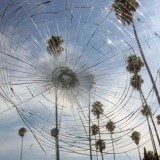 One technique for learning to draw is to study the negative space, the empty space around the subject you’re trying to capture. Doing so shortcuts our mind’s tendency to distort and stereotype the subject, say a building or a face. Draw the negative space, and you’ll be more likely to realistically capture the outline of your subject rather than ending up with the stick figures and child-like representations our mind naturally tends to portray.
One technique for learning to draw is to study the negative space, the empty space around the subject you’re trying to capture. Doing so shortcuts our mind’s tendency to distort and stereotype the subject, say a building or a face. Draw the negative space, and you’ll be more likely to realistically capture the outline of your subject rather than ending up with the stick figures and child-like representations our mind naturally tends to portray.
In our cities negative space, the open spaces between buildings, consists of vast seas of parking and empty, unused lawns. We all tend to filter out these spaces, failing to comprehend their size and ubiquitousness. Thankfully there’s a growing awareness that our city’s negative spaces are in fact negative, that they contribute to blight, profligate use of resources and our general unhappiness.
But a consciousness shift is underway led by forward thinking folks like the parishioners of Holy Nativity Episcopal Church in West Los Angeles who have teamed up with the non-profit organization Urban Farming to rip up their entire 1,200 square foot south lawn to plant vegetables for the congregation and the LAX Food Pantry. From their press release:
“Holy Nativity is a strong community center with focus on faith, hope, diversity, community and environment. The new Community Garden garden provides solutions to the issues of food insecurity, access to fresh produce, education on healthy eating, greening the environment, rising food costs and the importance of donating to those in need. Urban Farming and Holy Nativity, along with the project’s partners, will have a celebration event on Sunday, June 8. This garden is a partner in the Urban Farming campaign, “INCLUDE FOOD™ when planting and landscaping”.
During World War II, twenty million people planted “victory gardens” at their homes. They grew 40% of America’s produce. We did it then, we can do it again.”
Kudos to Holy Nativity and Urban Farming for this initiative and we hope the idea spreads to other churches, synagogues an mosques across the land–I wish I could attend the opening, but I’ll be assisting with the Bike Coalition’s annual River Ride fundraiser (not to late to sign up for that LA cyclists!). To those who can make it to Holy Nativity, the festivities run from 2 to 5 p.m. this Sunday June 8th. Holy Nativity is located at:
6700 W 83rd St
Los Angeles, CA 90045
(310) 670-4777
I had wanted to make a clever biblical reference at the beginning of this post and suggest that now, in 2008, Jesus would rip up the lawn, with the same fervor that he chased away the inappropriate money changers who did business in the temple. Dusting off the bible, however, I discovered that Jesus also shooed off some livestock during that episode. But with our increasing food troubles, I’d like to think that today, in addition to the vegetables, Jesus would welcome livestock back to the church grounds (cathedrals were used in the Middle Ages as barns, after all).
For more info and photos, see Holy Nativity’s Community Garden page.


Lawns are funny stuff in our culture. People dump big money into them, then go buy lousy trans-continental shipped veggies instead of growing their own.
Then they let the kids and dogs run all over them while they pretend to be cave men by grilling out over wood coals, usually dead things machined chewed and stuffed into intestines.
Not that that’s an all bad idea, the chili dog and the italian sausage may be deadly, but they sure can taste good.
I wonder if the idea of a big lawn came from the days of English lords clearing lines of fire and making pasture for animals, then maybe got swept up into the idea that you need to have one to look rich?
I got rid of almost all of mine, made my whole yard a garden and now am hugrily eyeing up the vacant lawn next to my house that the school doesn’t use.
I say death to monoculture-water suckin’ pesticide filled over fertilized snooty front yards! Instead I want a million points of veggie lights! This lawn agression cannot stand!
Or at least not without reel mowers and rainwater irrigation here in the Midwest.
I love this post and from my understanding, I think Jesus would too. I believe that the livestock in the bible story was being traded as a commidity and not being raised there for the good of the people – and that was the offence.
this is such a funny coincidence–just the other day i was telling my mr. that I thought churches would be a lot more affective if they used their lawn space for vegetable gardening. Of course, I’m knee deep in the bible belt, so there is a lot of not-so-green green space around here, which is what spawned the thought in the first place.
Why aren’t all churches doing this?